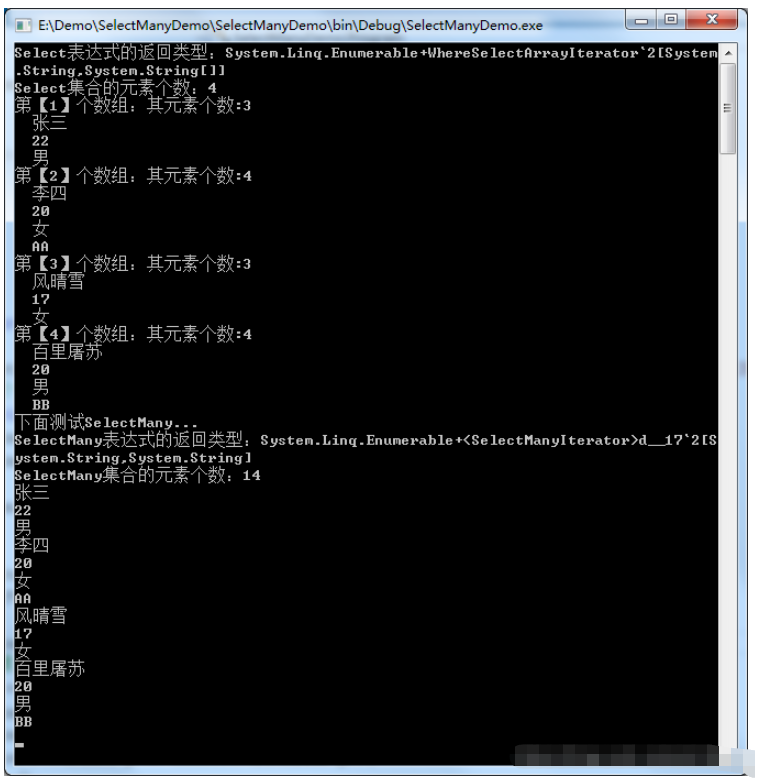您好,登錄后才能下訂單哦!
您好,登錄后才能下訂單哦!
本篇內容主要講解“C#中LINQ的Select與SelectMany函數如何使用”,感興趣的朋友不妨來看看。本文介紹的方法操作簡單快捷,實用性強。下面就讓小編來帶大家學習“C#中LINQ的Select與SelectMany函數如何使用”吧!
將序列中的每個元素投影到新表單。
返回結果:
System.Collections.Generic.IEnumerable`1 其元素是調用轉換函數的每個元素的結果 source。
Select只是每個元素獨立投影到新表單,每個元素獨自處理。
一個序列的每個元素投影 System.Collections.Generic.IEnumerable`1 并將合并為一個序列將結果序列。
返回結果:
System.Collections.Generic.IEnumerable`1 其元素是一種一對多轉換函數對輸入序列中的每個元素調用的結果。
SelectMany投影后合并元素。相當于將多個集合的每一個元素全部拼接,組成一個大的集合。
測試程序如下:
using System;
using System.Collections.Generic;
using System.Linq;
using System.Text;
using System.Threading.Tasks;
namespace SelectManyDemo
{
class Program
{
static void Main(string[] args)
{
string[] collection = new string[] { "張三,22,男", "李四,20,女,AA", "風晴雪,17,女", "百里屠蘇,20,男,BB" };
//Select只是每個元素獨立投影到新表單,
IEnumerable<string[]> selectCollection = collection.Select(person => person.Split(','));
Console.WriteLine($"Select表達式的返回類型:{selectCollection.GetType()}");
Console.WriteLine($"Select集合的元素個數:{selectCollection.Count()}");
int index = 0;
selectCollection.ToList().ForEach(p =>
{
index++;
Console.WriteLine($"第【{index}】個數組:其元素個數:{ p.Length}");
p.ToList().ForEach(s => Console.WriteLine(" " + s));
});
Console.WriteLine("下面測試SelectMany...");
//投影后合并元素。相當于將多個集合的每一個元素全部拼接,組成一個大的集合
var selectMany = collection.SelectMany(person => person.Split(','));
Console.WriteLine($"SelectMany表達式的返回類型:{selectMany.GetType()}");
Console.WriteLine($"SelectMany集合的元素個數:{selectMany.Count()}");
selectMany.ToList().ForEach(p => Console.WriteLine(p));
Console.ReadLine();
}
}
}程序運行結果截圖:

如果我們看這兩個擴展函數的定義很容易明白——Select是把要遍歷的集合IEnumerable逐一遍歷,每次返回一個T,合并之后直接返回一個IEnumerable,而SelectMany則把原有的集合IEnumerable每個元素遍歷一遍,每次返回一個IEnumerable,把這些IEnumerable的“T”合并之后整體返回一個IEnumerable。
因此我們可以說一般情況下SelectMany用于返回一個IEnumerable<IEnumerable>的“嵌套”返回情況(把每個IEnumerable合并后返回一個整體的IEnumerable)。因此在嵌套的時候往往可以節省代碼,例如輸出帶有以下的集合:
List<List<int>> numbers = new List<List<int>>()
{
new List<int>{1,2,3},
new List<int>{4,5,6},
new List<int>{7,8,9}
};通常情況下要遍歷一個嵌套的數組,我們不得不采用二重循環(for或者foreach),不過現在我們可以借助SelectMany進行簡化處理(把每個內嵌的List取出,因為每一個List都是IEnumerable,合并成一個大的IEnumerable)。
簡化如下:
var result = numbers.SelectMany(collection=>collection);
foreach(var item in result)
{
………………
}到此,相信大家對“C#中LINQ的Select與SelectMany函數如何使用”有了更深的了解,不妨來實際操作一番吧!這里是億速云網站,更多相關內容可以進入相關頻道進行查詢,關注我們,繼續學習!
免責聲明:本站發布的內容(圖片、視頻和文字)以原創、轉載和分享為主,文章觀點不代表本網站立場,如果涉及侵權請聯系站長郵箱:is@yisu.com進行舉報,并提供相關證據,一經查實,將立刻刪除涉嫌侵權內容。